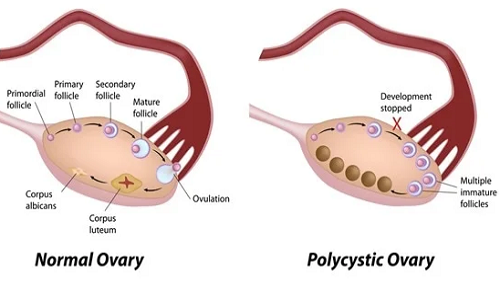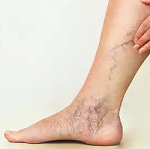AMENORRHEA
Written by Dr.M.D.Mazumdar, MD
What is Amenorrhea?
Amenorrhea (pronounced 'uh-men-o-REE-uh') is the medical term for the absence of a menstrual period. A woman is said to have amenorrhea when a menstrual period does not occur for more than three months in a row.
Amenorrhea affects about 10% of women worldwide. It is a common problem experienced by women of all ages at some time or other in their lives.
Types of Amenorrhea
There are two types of Amenorrhea.
Types of Amenorrhea
Physiological Amenorrhea : Physiological Amenorrhea or the Loss of Periods may be normal at certain periods in a woman's life, for example, during pregnancy, during breastfeeding, before attaining puberty and after the menopause. Read more...
Pathological Amenorrhea: Pathological Amenorrhoea or loss of periods is amenorrhea that occurs as a symptom of an underlying disease. It is not a disease process in itself.
Pathological amenorrhea will be described on this page. It can be further subdivided into two types:
- Primary Amenorrhea: When a girl has never experienced menarche and menses, she is said to be suffering from primary amenorrhoea or primary lack of menses. The cause is usually congenital, i.e. from birth, and is usually due to genetic or chromosomal abnormalities or due to a defect in the development of the reproductive tract. Treatment of this condition is very difficult.
In the United States, it is said to affect fewer than 0.1 percent of women.
- Secondary Amenorrhoea: When the patient has had at least one episode of spontaneous menses before the loss of her periods, she is said to suffer from secondary amenorrhoea. This is the commonest form of amenorrhoea.
The problem may lie in the hypothalamus and the pituitary, or the uterus or the ovary. Other endocrine glands like the thyroid, the pancreas and the adrenal cortex also have a role to play in causing amenorrhoea.
Causes of Pathological Amenorrhea
The Menstrual periods are regulated by a complex hormonal system. These involve the cerebral cortex, the pituitary gland, the ovaries and the uterus. Other glands like the thyroid gland also play an important part.

Causes of Amenorrhea
Amenorrhea due to Problems in the Cerebral Cortex
Stress - Stress is an important factor in causing amenorrhea. Stress can disrupt the production of hormones, disrupting the menstrual cycle. Stress can be emotional, physical or environmental.
- Emotional stress Emotional Stress like depression, mood swings and death of somebody close can trigger amenorrhea. Travelling or marriage or change in occupation can also sometimes cause temporary loss of periods. Stress during examination can also cause loss of menses or delayed periods.
- Physical stress Physical stresses like change in the diet or increased and excessive exercises ( such as long distance running) are important causes of stress induced amenorrhea. Loss of periods due to excessive exercise is also known as functional hypothalamic amenorrhea. When the body does not have enough energy to support regular menstrual cycles, it stops producing the hormones necessary for a period.
- Environment stresses Environment stress include shifting houses or cities, or an acute and sudden change in the weather can cause the periods to become delayed.
Psychoses - like Schizophrenia, mood disorders or treatment procedures for psychoses like electric convulsive therapy (ECT), or even drugs like antidepressants and antipsychotic drugs are also important causes.
Anorexia Nervosa- Anorexia Nervosa is an important psychological condition in which a girl eats too little food - this causes acute weight loss and amenorrhea. When the body does not have enough energy from food, it is unable to produce the hormones necessary for a regular menstrual cycle. Read more...
Pseudocyesis - Pseudocyesis is a condition in which a woman believes that she is pregnant and subconsciously suppresses her menstruation. She can also develop other signs of pregnancy like nausea and vomiting, an increase in body weight, breast changes and swelling of the abdomen. Read more...
Amenorrhea due to Pituitary Gland Causes
Hyperprolactinemia - Excessive production of the hormone Prolactin is called Hyperprolactinemia. High prolactin level (Hyperprolactinemia) may be due to a tumor or may be produced by the pituitary gland in the absence of a tumor. High prolactin levels can suppress the hormonal axis from the pituitary to the ovaries.
Post pill amenorrhea - Post pill Amenorrhea is a condition which occurs after a woman stops taking birth control pills. Birth control pills prevent a pregnancy by suppressing the hypothalamic-pituitary-ovary system. This suppression can continue after the birth control pills are stopped . Read more...
Sheehan's syndrome- Sheehan's Syndrome is a condition in which there is damage or destruction of the anterior lobe of the pituitary gland - usually due to excessive blood loss during childbirth. The pituitary thus fails to release hormones necessary to maintain the menstrual cycle and this leads to amenorrhea. Read more...
Amenorrhea due to Causes in the Uterus
Birth Defects- Certain birth defects such as the Mayer-Rokitansky-Kuster-Hauser (MRKH) syndrome can cause failure of development of the uterus and upper vagina, although the external genitals are normal. Affected individuals usually do not have menstrual periods due to the absence of a uterus.
Removal of the Uterus- due to conditions like uterine cancer.
Asherman's Syndome- Asherman's Syndrome occurs when there is damage to the interior of the uterus with formation of scar tissue. A common cause is too heavy curettage after D&C or abortion. Growth of the endometrium is thus prevented, causng loss of periods or amenorrhea. Read more...
Radiotherapy due to conditions like uterine or ovarian cancer can cause loss of periods.
Amenorrhea due to Causes in the Ovaries
Polycystic Ovarian Syndrome (PCOS) - Polycystic Ovarian Syndrome , also called the Stein-Leventhal Syndrome, is a condition in which the woman may have absent or irregular periods or very decreased flow of blood during her periods. Infertility or subfertility may also be the presenting complaint. Insulin resistance causing failure of ovulation is believed to be the main cause of irregularity or loss of periods. Read more...

Polycystic Ovarian Syndrome (PCOS)
Lack of or decreased production of estrogen and progesterone The lack of estrogen and progesterone are seen when the ovaries need to be removed due to the presence of tumors or complicated cysts.
Radiotherapy can also affect hormone production from the ovary . Less production of estrogen and progesterone can also be due to abnormal sex chromosomes like 47XXX, 46XX/XO.
Production of male hormones- Certain ovarian tumors like theca cell tumors or Dermoid cysts can produce predominantly male hormones and cause amenorrhea.
Other Causes Of Amenorrhea
Thyroid : Both hypofunction and hyperfunction of the thyroid can cause loss of periods.
Pancreas: Uncontrolled Diabetes mellitus can cause amenorrhoea, especially if the disease starts in childhood.
Adrenal Cortex : Tumours or hyperplasia of the adrenal cortex can cause amenorrhoea.
Chronic diseases : Most chronic diseases can cause amenorrhoea. Of these, tuberculosis is the most important as the tuberculous toxins appear to have a special affinity for the ovary and the uterine endometrium.
Nutritional Causes : Severe starvation as seen in malabsorption syndromes and during war and famine can cause loss of periods. On the other hand, severe obesity due to overeating or any other cause can also cause amenorrhoea.
Genetic or chromosomal disorders: such as Turner syndrome and Sawyer syndrome, can sometimes cause a late period. Fragile X syndrome (caused by the FMR1 gene) or fragile X-associated primary ovarian insufficiency (FXPOI).
Symptoms of Amenorrhea
Symptoms associated with amenorrhea are usually those of the underlying condition.
Infertility - Women with amenorrhea typically have low levels of reproductive hormones, which can affect their ability to conceive. Women who are trying to get pregnant should visit their doctor if they have not had a period for three months or more.
PCOS - Amenorrhea due to PCOS can be associated with symptoms like :
- Breast tenderness
- Increased weight gain
- Facial hair growth (hirsutism)
- Deepening of the voice.
- Headache.
- Vision changes.
- Nausea.
- Hair loss.
- Changes in breast size.
- Milky fluid, or discharge, from breasts.
- Fatigue
Diagnosis
The first step to diagnose the cause of amenorrhea is a thorough evaluation.
- Family history to identify a possible genetic cause.
- Hormonal tests for thyroid hormones, prolactin levels, female hormones like FSH, LH, estrogen and progesterone. Male hormones like testosterone can help identify PCOS.
- Ultrasound or an MRI to help detect any physical issues like tumors in the ovaries or uterus.
- Blood tests for blood sugar levels and also for a complete blood count.
When to see a doctor about loss of periods or absent menstruation.
The average age of puberty and menstruation is between ages 10 and 14. The first sign of puberty is usually breast development.
A teenage girl who has not started breast development by 14 years or who has not started her periods by at least age 16 should see a doctor.
Menstruating women and teens should see their doctor if they have missed three or more periods in a row.
Treatment of Amenorrhea
Treatment of amenorrhea depends on the underlying cause. Treatments focus on restoring hormone balance and improving overall health.
- Lifestyle changes - eating a balanced diet, reducing stress, and getting regular exercise can help treat amenorrhea.
- Hormonal therapy may be needed to restore hormone balance. Hormone Supplements in Hypothyroidism or Sheehans syndrome may be needed. Medicines will help decrease prolactin levels. Birth control pills, progesterone, estrogen and gonadotropin-releasing hormone agonists may be prescribed to help restore the menstrual cycle.
- PCOS may need long term treatment with medicines like Metformin to prevent insulin sensitivity, hormones to regularise periods or induction of ovulation if the patient needs associated treatment for infertility.
- Fertility treatments , such as ovulation induction, artificial insemination, and in vitro fertilization, can be used to treat infertility.
- Psychological counselling may be needed in conditions like Anorexia nervosa and Pseudocyesis.
Prevention of Amenorrhea
Amenorrea can be prevented to a great extent by:
- Maintaining a healthy weight
- Eating a well-balanced diet
- Exercising regularly
- Learning to manage stress
Amenorrhea can have serious physical and psychological effects. It is important to speak with a doctor or healthcare professional to identify the cause of amenorrhea and determine the best treatment option.
Read More:
Also Read-
- Interesting Facts about the Period.
- The Female Reproductive Organs.
- Vaginal Discharge with Itching .
- Causes of Male and Female Infertility.
Do you have a gynecological or obstetrical problem? Would you like to discuss it in private? Consult our online gynecologist Dr.M.D.Mazumdar, MD (O&G), at any time you want and get your reply within 24 hours.We charge a nominal fee of USD 20 ($20) per question through Paypal.com.
The procedure of asking a question is quite simple. Clicking on the link below takes you to the Paypal website where the payment is made. After the payment goes through, you will be directed back to this website where you can ask your question. And rest assured, you will get your answer within 24 hours. And usually, even sooner.



